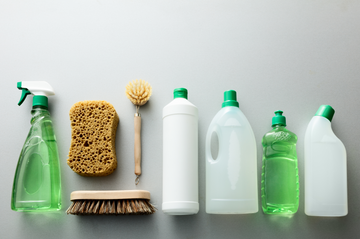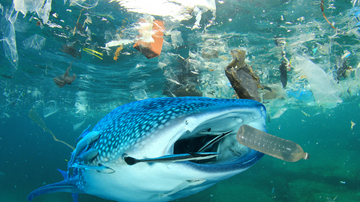Microplastic pollution has recently gained significant attention, and for good reason. Increasingly, studies are revealing the harmful effects of microplastics on both human health and the environment. These tiny particles can penetrate the human body, entering the bloodstream, gut, brain, and other tissues, potentially leading to serious health issues. While the full extent of their impact on our bodies is still being researched, one thing is certain: microplastics are everywhere. It’s crucial that we take steps to reduce both our exposure to them and our contribution to global microplastic pollution.
Here are 10 simple things you can do to reduce microplastic pollution and protect both your health and the environment:
1. Don’t Microwave Plastic

We've all been there—microwaving food in a plastic container because it's quick and convenient, and it saves you from washing extra dishes. But it's time to stop! Research has shown that microwaving food in plastic containers can release a staggering amount of microplastics and nanoplastics into your meal—up to 4.22 million microplastic particles and 2.11 billion nanoplastic particles from just one square centimeter of plastic after only three minutes of heating. Even containers labeled as microwave-safe are not entirely risk-free; while they may release fewer harmful chemicals compared to non-microwave-safe plastics, they still pose a potential risk to your health.
2. Don't Store Your Food in Plastic
Avoid storing your food in plastic containers for extended periods, whether at room temperature or in the refrigerator. Research shows that even without microwaving, storing food in plastic containers can lead to the release of millions of microplastics and nanoplastics. Refrigeration in plastic containers for more than six months can result in significant contamination from microplastics, though microwaving causes the highest release of these particles. To minimize your exposure, it's best to use glass or stainless steel containers for both storage and reheating.
3. Wear Clothes Made of Natural Fibres & Install Microfiber Filters to Your Washing Machine

The production, wearing, and washing of textiles made from synthetic (plastic) fibers is a significant source of microplastic pollution in the environment. Research shows that an estimated 15-36% of the microplastics released into the oceans come from synthetic textiles, with between 200,000 and 500,000 tonnes entering the global marine environment each year. Fast fashion is particularly problematic because the lower quality of these cheaply made garments leads to quicker deterioration. As a result, these items often don't last long, requiring more frequent replacement. environment.
Solutions include adding filters to your washing machine to capture most of the plastic residue generated during washing. However, the best approach is to adopt healthier shopping habits: invest in better quality products made from natural materials. While these may be more expensive than fast fashion items, they last much longer and significantly reduce your contribution to microplastic pollution.
4. Replace Single-Use Plastic Dinnerware with Eco-Friendly Alternatives

Single-use plastic is a major contributor to plastic pollution, accounting for nearly 50% of the 300 million tons of plastic waste generated globally each year. These often end up in nature where they can take hundreds of years to degrade into harmful microplastics. Moreover, using single-use plastic dinnerware and cutlery can directly expose you to microplastics, as these items can shed tiny particles into your food. Research suggests that individuals may unknowingly ingest between 37,613 and 89,294 microplastics annually just by using a single plastic cup every 4-5 days. Fortunately, there are 100% eco-friendly and toxin-free alternatives, such as palm leaf plates, which are made from natural, renewable resources and are free from chemical treatments during production. Check out our blog post about palm leaf plates to learn more about them.
5. Opt for Eco-Friendly Cosmetics

According to the Plastic Soup Foundation, a Dutch non-profit organization dedicated to ending plastic pollution, microplastics are present in 87% of products from leading cosmetics brands, including shampoos, facial scrubs, toothpaste, and makeup. These microplastics are often added as inexpensive exfoliators, stabilizers, or texturizers. Shockingly, 9 out of 10 cosmetic products contain microplastics that persist in the environment indefinitely.
To reduce your contribution to this pollution, consider switching to smaller, local cosmetics brands that use only natural ingredients. Opt for solid soaps, shampoo bars, conditioners, and tooth powders instead of their liquid counterparts. These alternatives often come in more eco-friendly packaging, such as paper or metal tins, and they typically contain fewer preservatives and additives, making them a healthier choice for both you and the planet.
6. Use Public Transportation
Car tires are a significant contributor to microplastic pollution. As tires wear down from friction with the road, they release plastic particles that accumulate in the air. In larger cities, this leads to the "city dust" phenomenon, where clouds of plastic and other debris form a persistent, invisible layer of pollution. This not only degrades air quality but also poses environmental and health risks. By choosing public transportation over driving, you can help reduce the wear on tires, thereby minimizing the release of microplastics into the environment.
7. Don't Buy Bottled Water, Apply a Water Filter Instead
Bottled water has been proven to contain high amounts of microplastics.
Install a water filter at home to reduce microplastic content in your drinking and cooking water, while also cutting down on plastic waste.
8. Refuse plastic packaging whenever you can

Reducing plastic waste starts with small, everyday choices. One of the most effective ways to cut down on plastic pollution is to refuse plastic packaging whenever possible. When you go grocery shopping, bring your own reusable bags, containers, and produce sacks. By choosing to carry your own packaging, you not only avoid single-use plastic but also set a positive example for others. This simple habit helps decrease the demand for plastic, contributing to a cleaner environment and a more sustainable future.
9. Collect waste the right way

Effective waste management is crucial for protecting our environment and conserving resources. Start by separating your waste into recyclables, compostables, and non-recyclables. Make sure to dispose of hazardous materials like batteries and electronics at designated recycling centers. By properly managing your waste, you reduce the amount of garbage that ends up in landfills and oceans, helping to minimize pollution and preserve natural ecosystems.
10. Educate and Raise Awareness









